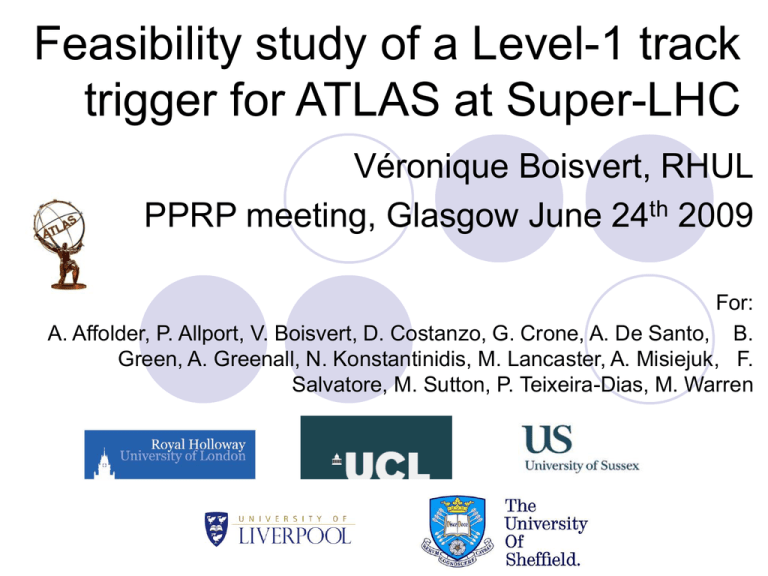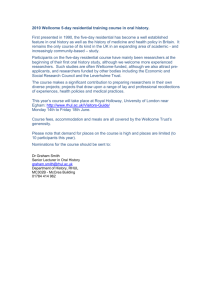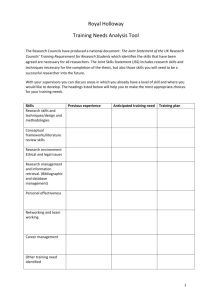L1TrackTriggerPPRP - RHUL Physics Department TWiki
advertisement

Feasibility study of a Level-1 track trigger for ATLAS at Super-LHC Véronique Boisvert, RHUL PPRP meeting, Glasgow June 24th 2009 For: A. Affolder, P. Allport, V. Boisvert, D. Costanzo, G. Crone, A. De Santo, B. Green, A. Greenall, N. Konstantinidis, M. Lancaster, A. Misiejuk, F. Salvatore, M. Sutton, P. Teixeira-Dias, M. Warren Outline Motivation for SLHC Motivation for a Level-1 Track Trigger Time scales and ATLAS organization Status of current work on the Level-1 Track Trigger The proposal Response to referees comments Veronique Boisvert, RHUL 2 Physics Motivations for SLHC SLHC is a luminosity upgrade to the LHC Extend discovery sensitivity Pin down the theory beyond the Standard Model Relatively modest investment to extend LHC capabilities In more details: (from hep-ph/0204087) 1. Improvement of the accuracy in the determination of SM parameters (TGC, QGC, Higgs couplings) 2. Improvement of the accuracy in the determination of parameters of New Physics possibly discovered at the LHC (e.g. sparticle spectroscopy, tan measurements) 3. Extension of the discovery reach in the high-mass region (e.g. quark compositeness, new heavy gauge bosons, etc) 4. Extension of the sensitivity to rare processes (e.g. FCNC top decays, Higgs-pair production, multi gauge boson production) Veronique Boisvert, RHUL 3 Physics Motivation for a Level-1 Track Trigger Conclusions from 2002 physics studies: 1. Most signatures require more than 1 leptons 2. pT requirement is low: 20GeV, ||<2.5 3. Total efficiency is assumed to be 90% 4. A lot of results are at the limit of what the SLHC can offer E.g. need 6000fb-1 to achieve 5 Implication: Need to retain the capability of triggering on objects at the electroweak scale in the harsh SLHC environment Is a Level-1 Track Trigger the answer? • In current system, tracking information is essential to the performance of Level-2 trigger • It would add flexibility to the system Veronique Boisvert, RHUL 4 Time scales and ATLAS upgrades Machine ATLAS LoI: Q2 2010 LHC: run for 8-10 years design luminosity: 1034cm-2s-1 25ns bunch crossing 23 proton collisions /bunch crossings SLHC Phase-I: ~2014 Peak luminosity: 2-3x1034cm-2s-1 UK 2010 2011 TP: 2011/12 2012 Tracker TDR: 2012/13 2013 2014 Level-1 Calo/Muon upgrade 2015 L1 TrackTrigger proposal until 30th June 2010 ATLAS upgrade full proposal 2010-2013 -Tracker - TDAQ - incl. Track Trigger - Computing 2016 18 months shut down SLHC Phase-II: ~2018 Peak luminosity: 1035cm-2s-1 25ns or 50ns bunch crossing 200-400 proton collisions/bunch crossings Particle flux about 20 times higher than LHC Veronique Boisvert, RHUL 2017 Replace inner detector with all-silicon tracker Readout electronics Trigger system 2018 5 Level-1 Track Trigger organization ATLAS wide Non-UK members working or interested in the project: USA: U. of Chicago, U. of Pennsylvania, U. of Indiana, + tracker upgrade institutes, e.g. Berkeley, Santa Cruz Japan: Tokyo, KEK, Kobe Sweden: U. of Uppsala Germany: Heidelberg U. Work Packages in view of the ATLAS upgrade Letter of Intent WP1: Simulation/performance/algorithms WP2: on-detector electronics WP3: data transmission WP4: off-detector electronics Veronique Boisvert, RHUL 6 Status of current work on the Level-1 track trigger Veronique Boisvert, RHUL 7 Current ATLAS trigger system 40 MHz 1 kHz 1 sec 200 Hz Region of Interest RoI 2.5 ms SLHC: ~6 ms? 10 ms Rate Level 1 trigger High Level Trigger 100 kHz L1 Track Trigger Level 2 trigger Event Filter Latency Veronique Boisvert, RHUL 8 Level-1 Track Trigger Options Impossible to fully read out the tracker for Level1 2 classes of options: Dedicated trigger layers • CMS choice Regional readout (Region of Interest based) • Within Level-1 latency: Tracking based on L1Calo/Muon input (L0A) • Outside Level-1 latency: On L1A, data moves to buffers but does not get read out until further command issued a few ms later (L1.5, “fast-clear”) If very large buffers on the Front-Ends, RoI processing approaches current Level-2 Whatever option Consequences for the tracker electronics are significant Veronique Boisvert, RHUL 9 Dedicated layers option Build double layers to look for coincidences (remove stereo angle functionality) Efficiency to have 1 coincidence with single electron or muon of 20/30GeV within 400 min bias events is high (~85%) Data rates: eg. 500 coincidences x 10 bits/coincidence x 40MHz = 200Gb/s /layer Barrel 400 pile-up QuickTime™ and a decompressor are needed to see this picture. Coincidences per event Coincidence layer Stereo angle Veronique Boisvert, RHUL E.g. for layer 5: 700 coincidences correspond to 25% occupancy 10 Regional readout options Studying: Size of RoI How often is a module in a Region of Interest? QuickTime™ and a decompressor are needed to see this picture. QuickTime™ and a decompressor are needed to see this picture. Barrel strip layer Veronique Boisvert, RHUL 11 Regional readout options Studying: On detector data reductions: Clustering done in the Front-end: about factor of 2 smaller data size Reject wide clusters: ~30% reduction QuickTime™ and a decompressor are needed to see this picture. Data flow latency Preliminary estimates come up with about 4.2ms for the track trigger (data transfer + processing) QuickTime™ and a decompressor are needed to see this picture. Veronique Boisvert, RHUL 12 Other current activities Using 1034/1035 simulation Rate studies to evaluate need and estimated performance of Level-1 track trigger Simulating upgraded L1Calo/Muon by using current Level2 algorithms Using upgraded-tracker-only simulations to study the various track trigger options Getting involved/providing input to the physics for SLHC group Veronique Boisvert, RHUL 13 The proposal Veronique Boisvert, RHUL 14 Members PI: Dr Nikos Konstantinidis (UCL) FTE: 20% Institutes: Sussex UCL PI: Dr Antonella De Santo PI: Dr Nikos Konstantinidis Total FTE: 40% Liverpool Total FTE: 80% PI: Prof Phill Allport RHUL Total FTE: 15% PI: Dr Veronique Boisvert Sheffield Total FTE: 55% PI: Dr Davide Costanzo Total FTE: 10% Veronique Boisvert, RHUL 15 Objectives and milestones Milestones: M1: provide feedback and L1Track requirements to the tracker layout task force By Q4/2009 M2: provide a baseline design for L1Track for the ATLAS LoI By Q2/2010 Objectives for next 12 months 1. Develop/optimise tools for studying simulated events with large pile-up 2. Study alternative designs for L1Track 3. Investigate pattern recognition algorithms and offdetector L1Track electronics 4. Study trigger rates and efficiencies at 1035cm-2s-1 and evaluate the benefits of L1Track Veronique Boisvert, RHUL 16 Costs All efforts are from existing Rolling Grant funded posts and FTE fractions are in line with current grants and grants currently applied for A little bit of “new money” for Sussex due to new academic appointments E&I costs for 01/07/09 to 30/09/09 Travel 5 UK meetings at average cost of 50GBP/person and 8 travelers per meeting, total: 2kGBP 40 international trips (10 travelers, 2 ATLAS upgrade weeks, 2 ATLAS TDAQ workshops) at 500GBP per trip, total: 20kGBP To be administered centrally by RAL-PPD Veronique Boisvert, RHUL 17 Costs QuickTime™ and a decompressor are needed to see this picture. Veronique Boisvert, RHUL 18 Response to referees comments Clarification on PI: Dr Nikos Konstantinidis, 20% FTE, co-leader of the ATLAS wide Level-1 Track Trigger effort, will be on sabbatical at CERN for next 18 months. International context and partnerships See previous list of international partners on ATLAS Strong ties on this project with Level-1 Calo/Muon: Most Level1-Calo expertise is in UK and already work closely with members Level1-Muon institutions are involved at ATLAS level with the project Veronique Boisvert, RHUL 19 Response to referees comments Project management Project will last 12 months and involves few members, so light structure is appropriate Working meetings once a month PIs of each institute will discuss at the end of each meetings to address any necessary management action Sharing of tasks between members Bulk of FTE on UCL, RHUL and Sussex Liverpool and Sheffield consultancy is essential since involved in tracker upgrade and simulation work Veronique Boisvert, RHUL 20 Response to referees comments Project timescales and long term planning This proposal only covers next 12 months: To look at need for Level-1 Track Trigger To come up with baseline design for the ATLAS LoI In process of writing a 3 year proposal (2010-2013) for which there will be additional resources needed to come up with a more detailed design and possibly a prototype Travel funds Members will be efficient with overlap with ATLAS meetings Upgrade meetings not covered under ATLAS travel Sussex does not have ATLAS travel Veronique Boisvert, RHUL 21 Response to referees comments Premature to talk about ATLAS upgrade? Current ATLAS silicon tracker took 10 years from TDR to completion of construction Estimate that for upgraded tracker fastest would be 5 years If want to run upgraded ATLAS by ~2020, then need TDR by 2014 at the latest (allowing 1 year of procurement) Need all R&D, qualification and pre-series studies to happen before then Veronique Boisvert, RHUL 22 Conclusions Every experiment that built a hardware track trigger (H1, ZEUS, CDF, …) highly benefited from it The UK currently has leadership in the project We have the leadership and technical skills to become an important player of this important upgrade activity This proposal is the first step along that road Veronique Boisvert, RHUL 23 Backup slides Veronique Boisvert, RHUL 24 QuickTime™ and a decompressor are needed to see this picture. Nessi, 09/06/09 Veronique Boisvert, RHUL 25 QuickTime™ and a decompressor are needed to see this picture. Veronique Boisvert, RHUL 26 QuickTime™ and a decompressor are needed to see this picture. Veronique Boisvert, RHUL 27 QuickTime™ and a decompressor are needed to see this picture. Veronique Boisvert, RHUL 28 QuickTime™ and a decompressor are needed to see this picture. Veronique Boisvert, RHUL 29 QuickTime™ and a decompressor are needed to see this picture. Veronique Boisvert, RHUL 30 QuickTime™ and a decompressor are needed to see this picture. Veronique Boisvert, RHUL 31 QuickTime™ and a decompressor are needed to see this picture. Veronique Boisvert, RHUL 32 QuickTime™ and a decompressor are needed to see this picture. Veronique Boisvert, RHUL 33 QuickTime™ and a decompressor are needed to see this picture. Veronique Boisvert, RHUL 34 Examples relevant to L1Track Trigger 1. Multiple Gauge boson production QuickTime™ and a decompressor are needed to see this picture. Studies assume: 90% id efficiency for each lepton |l|<2.5, PTl>20GeV 2. Hmm: LHC: not better than 3.5 Study assumes: 90% id efficiency for each muon |l|<2.5, PTl>20GeV Veronique Boisvert, RHUL QuickTime™ and a decompressor are needed to see this picture. 35 Examples relevant to L1Track Trigger 3. Top FCNC tq: 1 iso. ET>75GeV, ||<2.5 1 l pT>20GeV, ||<2.5 Jets QuickTime™ and a decompressor are needed to see this picture. tqg: 1 l pT>20GeV, ||<2.5 Jets QuickTime™ and a decompressor are needed to see this picture. tqZ: 3 l pT>20GeV, ||<2.5 Jets 4. SUSY: Point K Meff = ETmiss + ETjet + ETlepton lepton ET>15GeV Veronique Boisvert, RHUL QuickTime™ and a decompressor are needed to see this picture. 36 Examples relevant to L1Track Trigger LHC 10fb-1 5. ED in RS model LHC 100fb-1 Gll SLHC 1000fb-1 Conclusions from examples: 1. Most signatures require >1 leptons 2. Offline pT cut is always >20GeV, ||<2.5 Don’t know dependence of results vs pT, cut L1 Track Trigger will have to be both barrel and endcap 3. Total efficiency is assumed to be 90% Don’t know dependence of results vs efficiency 4. A lot of results are at the limit of what the SLHC can offer E.g. need 6000fb-1 to achieve 5 Veronique Boisvert, RHUL 37 Trigger Strategy at SLHC Very high pT for discovery physics Low pT thresholds but then use multi-objects or exclusive (1 el + MET + N jets) triggers Can we achieve this? What impact does this have on physics goals? Prescaled control/calibration triggers QuickTime™ and a decompressor are needed to see this picture. Veronique Boisvert, RHUL From scaling of L1 TDR, does not take into account full pile-up or cavern background 38 L1 Muon One of the reasons for CMS getting L1 Track trigger is flatness of L1 muon rate Kawamoto, 13/11/08 QuickTime™ and a decompressor are needed to see this picture. See e.g. arXiv:0810.4133 Turns out ATLAS is also pretty flat But feasible solutions related with adding layer to Muon Note that this is meant to address how the rate should be falling with pT thresholds But ideally we don’t want to raise those! Absolute rate will decrease by how much? Veronique Boisvert, RHUL Mikenberg, 26/02/09 QuickTime™ and a decompressor are needed to see this picture. 39 Time scales and ATLAS upgrades Machine LHC: run for 8-10 years design luminosity: 1034cm-2s-1 25ns bunch crossing ATLAS LoI: April 2010 TP: 2011/12 Tracker TDR: 2012/13 SLHC Phase-I: ~2014 Peak luminosity: 2-3x1034cm-2s-1 Level-1 Calo/Muon upgrade UK L1 TrackTrigger proposal until 30th June 2010 ATLAS upgrade full proposal 2010-2013 -Tracker - TDAQ - incl. Track Trigger - Computing 18 months shut down SLHC Phase-II: ~2018 Peak luminosity: 1035cm-2s-1 25ns or 50ns bunch crossing 200-400 proton collisions/bunch crossings Particle flux about 20 times higher than LHC Veronique Boisvert, RHUL Replace inner detector with all-silicon tracker Readout electronics Trigger system 40




